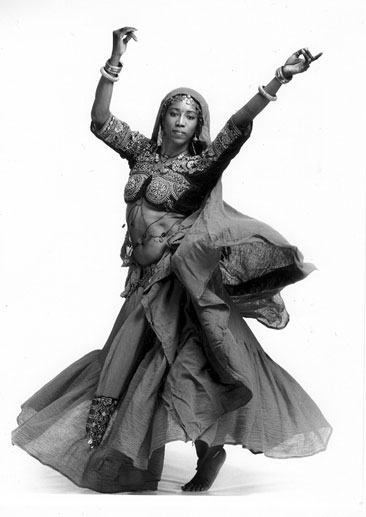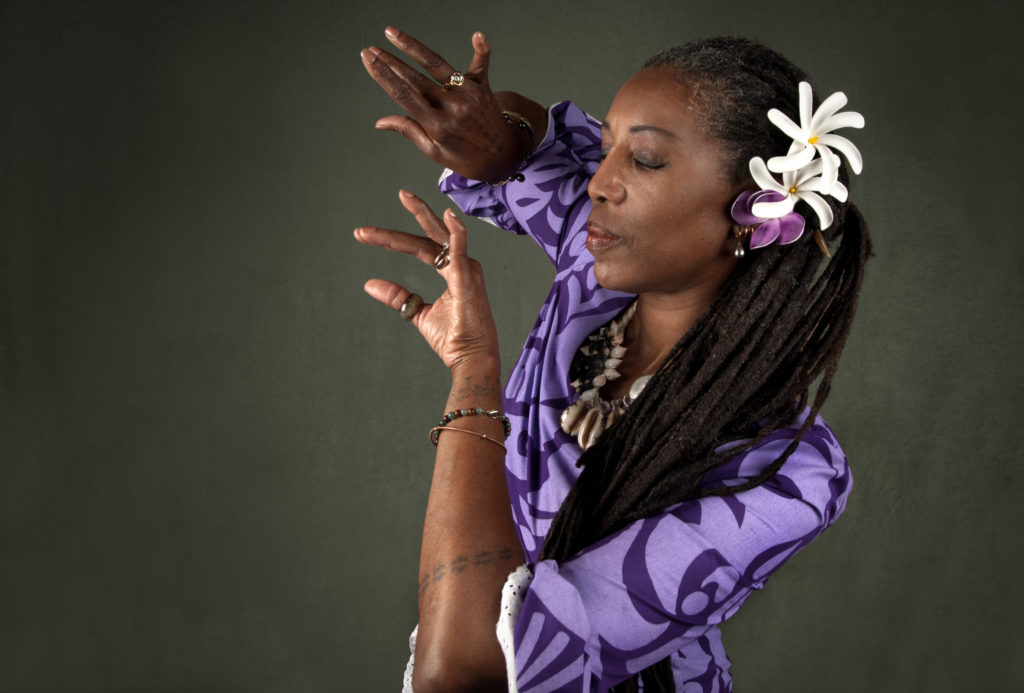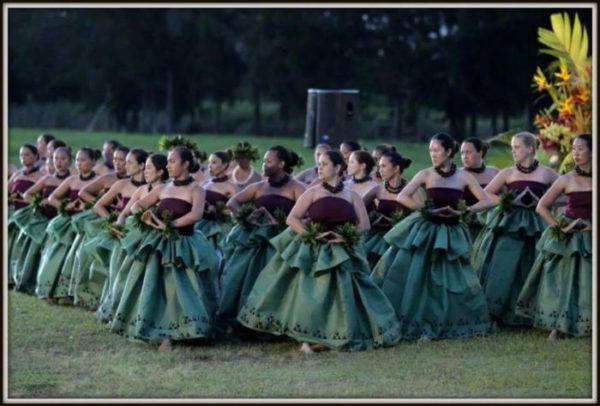This month the Mahea Uchiyama Center for International Dance celebrates its 25th anniversary. And although no institution, especially an arts institution, makes it to 25 years without the toil and TLC of scores of individuals, the Center owes its energy and longevity to the passionate expertise of founder, artistic director, and kumu hula (master hula teacher) Mahealani Uchiyama.
Uchiyama was born in Washington DC. She arrived in the Bay Area by way of Honolulu in 1982, with an undergraduate degree in Dance Ethnology[1] and a master’s degree in Pacific Islands Studies from the University of Hawai’i at Manoa. In 1993, after teaching hula at Chabot College in Hayward, Laney College in Oakland, and at private dance studios she rented throughout the East Bay, she established her dance center on Heinz Avenue in Berkeley and founded her current performing company, Halau Ka Ua Tuahine. In addition to Hawaiian and Tahitian dance, the school has brought together instructors of the dance and music of Bali, the Middle East, India, China, Congo, Central Asia, Zimbabwe, Senegal, to name a few. This month’s anniversary gala and performance will reflect that diversity.
Uchiyama explains that the Center is a place where “non-Western forms can be explored regardless of an individual’s background and ethnicity, as long as they are willing to do so in a spirit of profound respect. This is the place for all of us, a place to feel at home exploring spiritual and artistic connections.” The theme of finding home—in a geographic place, a body, a dance form—recurs throughout our interview.
Uchiyama had just completed her first season as co-director (with Patrick Makuakane and Latanya Tigner) of the San Francisco Ethnic Dance Festival, and was taking a breath before launching preparations for the anniversary performance when we spoke in her Oakland home on July 26.
Sima Belmar: How did an African American woman born in DC at the height of the Civil Rights Movement become a kumu hula?
Mahea Uchiyama: My mom, who had grown up in the Jim Crow South and migrated north, was determined to provide access to all the things that she had wished for as a little girl but couldn’t have. She enrolled me in the Bernice Hammond School of Dance, a black owned business and the only dance school in the District of Columbia that would accept black children. I was there for nine years, from the age of two and a half until I was almost 11, at which point I was old enough to notice that I was not seeing any ballerinas who looked like me in terms of height (I was already 5’11) and race. Even so, with everything that was going on in the world at that time, dance made it possible for me to feel some sense of self-worth and hope. I knew that I didn’t want to give up dancing but if I kept doing that style of dance there wouldn’t have been any future for me that I could see.
My mom also got me into one of the very few if not the only elementary school in DC that was integrated. I was the only black child, but I was there with children of ambassadors and children of the housekeepers of those ambassadors, so there were kids from all over the world. From the 5th grade on my sense of the world expanded dramatically compared to what it would have been had I continued to only experience life within my own neighborhood. So all of this started me thinking: Why do people move the way they move? I was fascinated with different people’s ways of expressing themselves through movement. I also loved being exposed to different languages, music, and food.
 SB: So early on you developed an embodied ethnographic sensibility.
SB: So early on you developed an embodied ethnographic sensibility.
MU: Yes, which led me to be interested in different histories and geographies. Why do we have all these different, fascinating, beautiful ways of saying the same things? So that led me to dance ethnology. There were two programs I was aware of, one at UCLA and the other at the University of Hawai’i.
SB: Why did you choose to move 6000 rather than 3000 miles from home? How did your family feel about that?
MU: I really wanted to study hula in Hawai’i. I had started taking hula lessons at the age of 13. In DC, each state had their own State Society, where families of people who served in the government got together to promote what’s unique and wonderful about their state.[2] My mom contacted the Hawai’i State Society and they put us in touch with people who taught hula and Tahitian dance. I got really fascinated by it.
SB: What did you find when you got to Hawai’i?
MU: It was a mixed bag. It’s incredibly beautiful, and I did find a lot of wonderful friends and a whole different sensibility of how to be in the world. I also found a lot of people, outside the university context, who made it clear that they did not have a very high regard for African-American people. I was not in the military, or on the basketball or volley ball team, so some people just couldn’t grasp that I was there as a regular student. I was there really by myself, no family, and no discernible black community in Honolulu at that time. I felt very alone, but I was also determined to graduate before I left.
SB: What made you leave?
MU: The whole reason I went to Hawai’i was that I wanted to dance hula, and I wanted to explore different ways of being in the world through movement. In addition to hula, and as part of my degree requirements as a Dance Ethno student, I took classes in everything that department offered in those years—Filipino, Okinawan, Korean, Javanese, Mohiniyattam. Additional experiences included playing in the university’s Javanese gamelan, and receiving instruction in South Indian classical singing.
When I first moved to Hawai’i as a naïve and innocent young woman, I just wanted to dance and to be a part of that place. Over time it became clear that there were certain things that at least at that time, were not likely to be possible for me to achieve in terms of finding a sense of “home”. In addition, as both my husband and I were teachers, it felt very unlikely that we would ever be able to buy a home there.
SB: At least you got to the Bay Area in time to do that.
MU: Barely!
SB: What did you find when you arrived in the Bay Area?
MU: When I first came here I was amazed at how big and active the Polynesian dance community was (and still is).
SB: Was it easier to integrate with the Polynesian community in exile? How were you received by that community?
MU: In those years, many people were very welcoming. However, there were also those who were like, “what are you doing speaking Hawaiian?” There were some who couldn’t get past the misconceptions of what they thought my phenotype represented. Fortunately, when I arrived a friend introduced me to Uncle Joseph Kaha’ulelio, a renowned kumu hula who was teaching in Hayward. I studied intensely with him for several years, and danced in competitions and events all over the Bay Area. I found complete acceptance with him, something I ever had never experienced in full before.
SB: Describe your process of creating hula performance works.
MU: I’ve always tried to adhere to the traditional expression and to honor it. As a kumu, one of my jobs is to innovate and create in ways that honor and draw from a wellspring that was passed on to me by my kumu. Walking that fine line has always been the challenge. It is vital to fully understand every aspect of what we are doing as a teacher of this tradition, (the music, the narrative, the regalia, and of course the movement sequences) and simultaneously to create something that’s beautiful and consistent with tradition, yet something unique that hasn’t been seen before.

First and foremost in preparing a hula is the narrative. Hula is a logogenic art form. So, in the absence of a poem or a prayer, there’s no hula. Dancers have to be trained so that the movement becomes a part of their DNA in order to make it possible to express this narrative through their body. A kumu must have a clear understanding of how to clothe the dancers, because every single item worn, its color, design and materials has to be in accordance with and expressive of the meaning of the dance that is being presented at the time. Even how a dancer wears their hair must be attended to in detail, as must how much make-up they’re wearing, if any, what kind of lei they wear, how the lei are made, and how the component parts of the lei are collected. Hula is a lifestyle, it’s not just something one does in the studio. When we’re in Hawai’i, getting ready to create our regalia for our ceremonies, we ask permission before we enter a forest and again when we approach the item that we want to gather. We only take what is needed. While crafting the lei, it is important to focus on positive intention, as what is on your mind can go into what you are creating. Once we are done with the ceremony or the performance, the lei is respectfully returned to nature. This is our way. This is how we try to work with our students so that they understand how they relate to the world around them. The point is understanding who you are in relation to your community, and that community is understood to be not just your people but the plants and the air and the mountains. The performance aspect is the outward expression of this training, but it is not the most important thing.
SB: Your center is home to so many different cultural forms, and you studied multiple forms in college. What has it meant to your embodied identity to have been inside these different forms?
MU: When I first came to Oakland, I noticed that there was a huge tradition of African based forms, and I got very interested in learning them. For a number of years I danced with the Orinoco Caribbean Dancers and Drummers. We performed the regional dances of the Caribbean. In those years I also started learning Middle Eastern dance. In the 1990s, the late Pandit Chitresh Das started teaching at my studio, and I had the extreme good fortune to study with him as well. I love movement, I love to see and feel what it is to really immerse myself in different ways of being and I also think it’s really healthy for my teaching to be reminded how it feels to be a beginning student.
Each form meant different things to me. When I was doing the regional Caribbean dances, for example, it felt like a bit of a homecoming because for the first time in my life, I sensed that everyone within a particular dance community considered my body type acceptable for a form that I loved. I had walked into a situation where I was celebrated and recognized for those very features that in my youth and naivete I had grown to feel badly about. That’s a lot of what I got from that experience, that grounding, and that understanding that there are different ways of seeing.
SB: Given that experience of homecoming in the Caribbean forms, and that sense of alienation from at least the social context of hula, what kept you going in hula?
MU: Hula was always been my core and it remains my core. I love the form. There was a spiritual connection that made sense to me. My heart was telling me that this is a beautiful dance form and I just followed that. At the same time, I began to understand that when you’ve had something taken from you, or almost taken from you, you get very possessive about what you have of it left. So, I get why some Hawaiians are quick to express caution toward people of other backgrounds who say they want to explore (but also possibly appropriate and exploit) that which is sacred to them. Encountering that attitude before I had developed an understanding of it was very rough and painful for me, but I get it now. Certainly we too, as black people, have had much taken from us.
SB: So your own history plus the knowledge you gained of Hawaiian history gave you a compassionate perspective on those that might have made you feel like you don’t belong. And it seems this made it possible for you to have felt a sense of homecoming in the Caribbean forms without it having to mean you had to live there. Your story inspires trust in the body’s intuitive sense of home, one that may or may not correspond to one’s geographic, cultural, ethnic, or social origins. What do you hope your work can do to intervene into those nefarious global efforts to confine individuals to a narrow sense of home based on nationalist and racist borders?
MU: It is more urgent than ever that we find ways to recognize each other’s humanity. Dance and music are good ways to start to get a sense of a people. What I see as my contribution is to help us as a community to get to know each other, and to be willing to see ourselves in each other.
SB: How specifically does hula help us recognize each other’s humanity?
MU: Hula is a reminder that we are part of something big, and a spiritual recognition of our place in the world. The extent to which our environment is healthy is the extent to which we ourselves are healthy. Hula gives us this awareness, and it helps us to see ourselves in each other, in the trees, and in the ocean. Spirit is everywhere and we are a part of that. The realization that we are connected to each other and to everything in the environment leads to a greater sense of the importance of caring for each other and for the world.
In June we participated in the 5th World Conference on Hawaiian Hula, Ka ‘Aha Hula ‘O Halauaola. This event began 17 years ago and was created by three wise and powerful kumu hula who realized that people were dancing hula all over the world without necessarily understanding the full depth and meaning of the tradition. The event occurred every four years, each time on a different island. As each island hosted the conference, there would be a hula ceremony for which we would learn ceremonial dances that related to the place. The first conference was on Hawai’i Island. We went from there to Maui, to Oahu, to Kaua’i, and then finally, back to Hilo on Hawai’i Island.

Much of the hula tradition is based on the epic story of the volcano Goddess Pele and her siblings, particularly her youngest sister Hi’iakaikapoliopele, who was sent on a journey from the Hawai’i Island to Kaua’i to find Pele’s dream lover and bring him back to Pele. She had many obstacles along the way, and it took time for her to complete her journey. However, overcoming the various challenges on each island, Hi’iaka became aware of who she was as a healer, as a priestess, and as a goddess. She returned in full realization of who she is.
Those of us who participated in each of the conferences over the years essentially traced the same path as did Hi’iaka. The dances that we were given to learn for the recent ceremony spoke of all those events, including the eruption and destruction of Hi’iaka’s sacred garden. As hula practitioners from all over the world were working on the ceremonial dances, the latest eruption occurred with fissures opening up throughout an area known traditionally as Keahialaka. (The name translates to the fire of Laka, the hula Goddess. This is an area known in ancient times as the site of frequent volcanic activity.) In the 1960s, this area was renamed as Leilani Estates. Just as Hi’iaka, after her circuit, arrived back to this eruption, so did all of us.
Pele is about giving birth. Pele’s womb is the earth and from it she creates new land. Hi’iaka follows her, and brings new life to this gift of new land. Such metaphors and archetypes from Hawaiian spirituality explain a lot of what we experience in the environment. If one is sensitive and open, the hula can reveal quite a bit about what to expect and how to respond.
[1] There is currently one dance ethnology course offered at the University of Hawai’i, Manoa, according to the 2018-19 course catalog. The dance department’s current foci include choreography, kinesiology, movement analysis, heritage, globalization, technology, ethnography, education, corporeality, visual media, and embodiment, with a unique focus on Asian and Pacific dance.
[2] The National Conference of State Societies (NCSS) began as informal gatherings of State society officers in the 1930s and is currently best known for its annual National Cherry Blossom Festival. Uchiyama had her first introduction to hula at a Hawai’i State Society of Washington DC event.
This article appeared in the September 2018 edition of In Dance.

